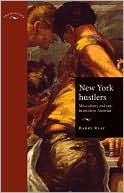 New York Hustlers: Masculinity
New York Hustlers: Masculinity
and Sex in Modern America
by Barry Reay
Manchester University Press. 208 pages, $35.
THE HUSTLERS in this book’s title are self-identified straight men who exchange sex for money with a homosexual clientele. Author Barry Reay, a professor of history at the University of Auckland, claims that through this lens he can examine a slice of heterosexuality as well, since these men cross over the great divide between homo- and heterosexual worlds. Reay’s study, which covers the years from the 1940’s through the 60’s, focuses on the category of men known as “trade,” which he describes as “ostensibly straight and similarly masculine men, often those in uniform, who would engage in same-sex sex.” Indeed the hustler’s sexuality was a key ingredient in his appeal. As Edmund White remarks in My Lives (2005), reflecting on this period: “We wanted a real man, a heterosexual man.”
Some hustlers presented the possibility of danger and violence as well, which heightened the excitement for many men. White goes on to observe that his encounters with hustlers “were as much an expression of fear as of desire.” Kinsey informant Thomas Painter admitted that the danger factor often contributed to the allure of his partners, some of whom were convicted criminals. Reay’s research reveals that a number of well-known American composers, among them Virgil Thomson, David Diamond, and Ned Rorem, favored “rough trade” in this era.
Reay’s hustlers were a fairly varied lot: sailors on shore leave who would let “fairies” fellate them; working-class men from rural areas of Pennsylvania and other nearby states who needed money; Puerto Rican street gang members; and Coney Island bodybuilders. But the majority of “gay for pay” trade were full-time sex workers who lived by working the bars and streets.
Reay draws much of his research from the Kinsey Institute in Bloomington, Indiana, and reproduces many photographs from the Thomas Painter Collection. Indeed Painter himself, a prolific procurer of ultra-masculine hustlers, takes a prominent place in Reay’s account. A valuable informant for Kinsey until the sex researcher’s death in 1956, Painter continued to provide the Institute with records of his sexual activities until the early 70’s. In writing to Painter in 1950, Kinsey remarked that his letters contained more insight “than anything I have seen in the psychiatric literature.”
The male hustler also became a ubiquitous figure in the works of many prominent artists and writers of the times, especially those who may occasionally have paid for sex, including writers Tennessee Williams and Gore Vidal, painters Jasper Johns and Robert Rauschenberg, and filmmaker George Cukor. The author quotes Vidal’s 1997 memoir, in which he reflected on the 1940’s as a time when “just about everyone, either actively or passively, was available under the right circumstances.” Reay’s introduction alone fills the pages with a dizzying array of anecdotal references and name-dropping. “The list could go on and on,” he sighs.
Many of these men-for-hire established their own sexual repertoires, often deviating from expected roles. One unidentified hustler enjoyed both active and passive anal sex while proclaiming, “At least I’m not a cocksucker!” Reay quotes a 1969 passage from the New York diarist Donald Vining, who sometimes “played trade”: “I, for instance, like to suck and fuck, but do not care much for being fucked and am so indifferent to being sucked that I frequently cannot reach orgasm that way. … My sexual preferences are both aggressive acts and the passive acts don’t interest me much, tho on occasion they can if performed by masters. We’re a varied lot and I’ve seen few theories that fit many of the people I know.”
Copious endnotes follow each chapter interspersed with photos of hustlers and the works of artists such as Paul Cadmus. Reay focuses on the world that they inhabited rather than on individual hustlers, with a few notable exceptions. Among the latter is longtime hustler and fiction writer John Rechy, who underwent a transformation from the 1960’s to the 1970’s that Reay describes as “the homosexualization of the hustler.” He quotes Rechy from a 1973 interview: “Hustlers used to be ‘strictly straight.’ We weren’t, of course. That was bullshit, but bullshit we were doing ourselves. But that’s what was expected of us.” It was the gay liberation movement of the 70’s that freed hustlers from the heterosexual mandate. What Rechy’s case reveals is that many of the putatively straight hustlers of the earlier period were really gay men after all. Part of the hetero routine was probably due to internalized homophobia, a factor that Reay largely dismisses.
Reay’s attempt to uncover a neglected period in the history of masculinity and sexuality by “traversing confusing sexual terrain” of hustlers is often fascinating and sometimes unsettling. Reay concludes on a humble note: “If this book helps to chart an earlier history, a history that destabilizes rather than merely confirms sexual identities, it will have been worth writing.” With this objective in mind, reading New York Hustlers can be time well spent.
________________________________________________________
Dean Wrzeszcz is a contributing editor at New York’s Gay City News and is working on his first book of autobiographical essays.





